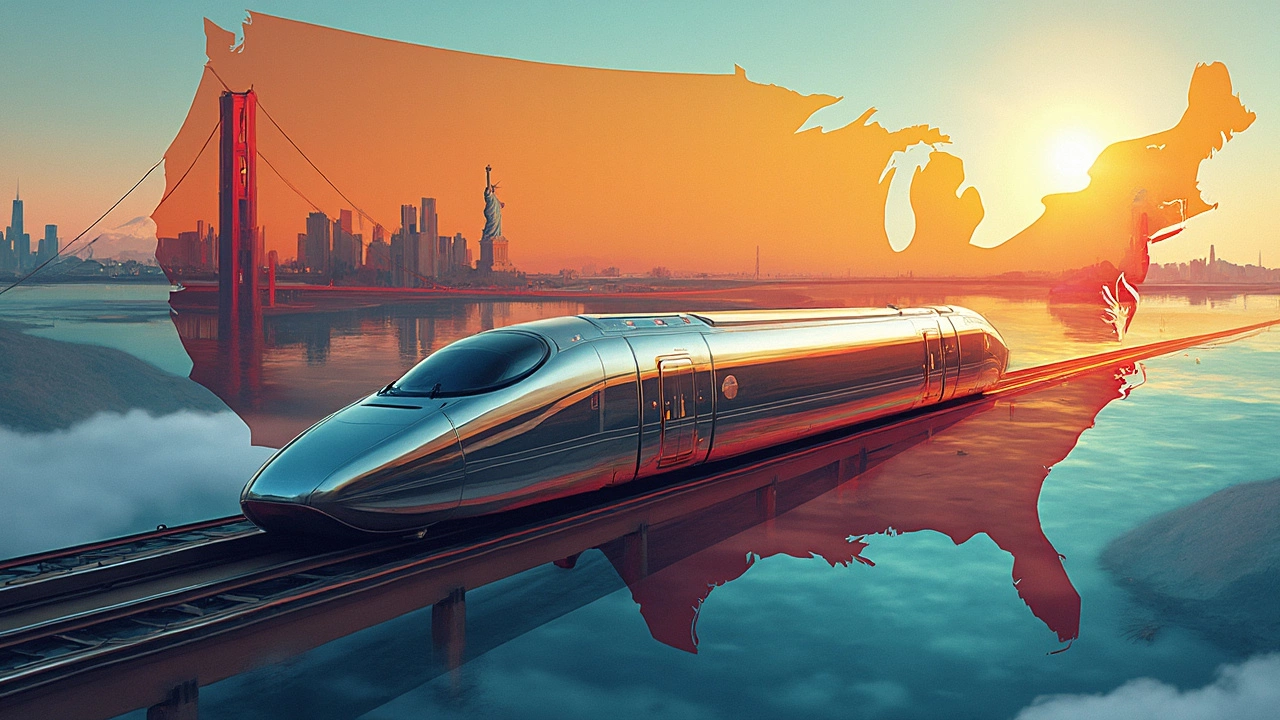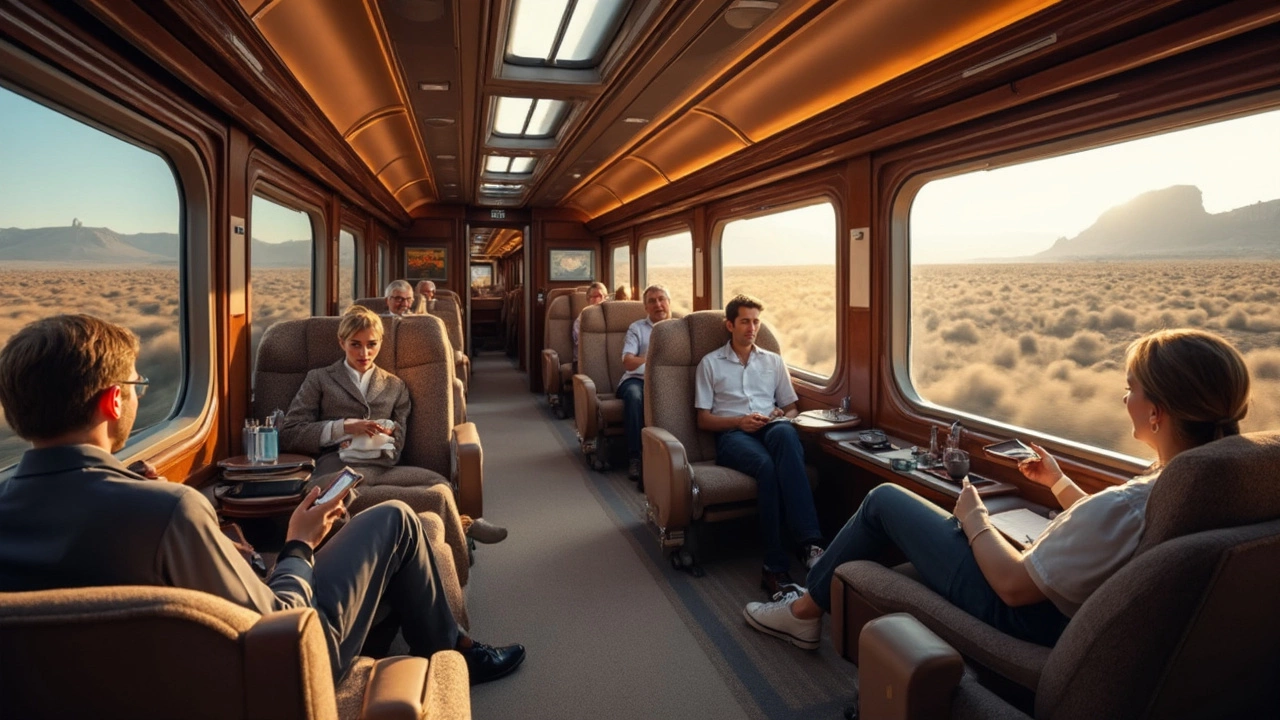Bullet Train Journey: New York to California in Record Time

- Feb, 8 2025
- 0 Comments
- Aaron Blackwood
Picture a future where you could zip from New York to California on a bullet train in just a few hours. It sounds like a scene out of a sci-fi movie, but with the right technology, it could become reality. So how long would it actually take? Well, if we look at Japan's Shinkansen or France's TGV, these trains can reach speeds over 200 mph. With some quick math, a bullet train could potentially make the trip in around 15 hours, a significant improvement over current options.
Now, let's talk about what makes a bullet train different. Unlike regular trains that amble along exchanging scenic views for time, bullet trains are all about speed and efficiency. They travel on specially designed tracks that minimize friction and swerve, much like a race car on a well-paved track. Plus, their aerodynamic build reduces drag, allowing them to maintain high speeds safely and comfortably.
- Current Train Travel Times
- The Bullet Train Difference
- Potential Routes and Stops
- Luxury Onboard Experience
Current Train Travel Times
Alright, so if you were planning to take a train from New York to California right now, buckle up for a long ride! An average Amtrak journey can take upwards of 70 hours. That's nearly three days of travel time, not counting any unforeseen delays.
Most routes like the Amtrak's California Zephyr, which runs from Chicago to San Francisco, or the Sunset Limited connecting Los Angeles to New Orleans, offer scenic views and all of that, but they're not exactly speed demons. We're talking maximum speeds of 79 mph, which feels pretty leisurely compared to the potential speed of a bullet train.
On top of the long hours, think about the stopovers. These trains make numerous stops along the way. It's not just direct from the Big Apple to the Golden State. You'll be visiting a variety of stations where passengers board and disembark, adding even more time to your journey.
There's a certain charm to long-distance train travel, sure. It's a way to see the country up close, enjoy some onboard dining, and maybe make a few friends in the observation car. But if we're talking efficiency and speed, current options are miles behind what luxury train journeys could achieve with the introduction of high-speed rail like bullet trains.
The Bullet Train Difference
High-speed trains have been a game-changer for long-distance travel across the globe. Take a look at the bullet train, also known as the Shinkansen in Japan, which tops out at speeds of 200-320 mph, depending on the series. The European counterpart, the TGV in France, reaches similar velocity, making these trains far quicker than most planes on short routes when you consider check-in and security times.
So how do these trains maintain such blistering speeds? It all starts with the tracks. Unlike conventional railways, bullet trains run on dedicated, purpose-built lines that minimize curves and steep gradients. This allows for smoother rides at higher speeds. The trains themselves boast an aerodynamic design, with a sleek, pointed nose designed to cut through air resistance efficiently.
Why Aren't They Everywhere?
While bullet trains are incredibly effective, they aren't yet a mainstay everywhere due to high costs and infrastructure needs. Building a single mile of high-speed rail can cost millions of dollars. Yet, as demand for faster and greener transport grows, countries are increasingly looking towards this technology.
New York to California gives us a particularly intriguing case study. While current Amtrak services take days, a bullet train would shrink this journey dramatically. The potential route would require a vast investment but imagine the boost to travel and trade such a connection could provide.
Not Just About Speed
Another key difference with bullet trains is the onboard experience. Think luxury train journey, but with the speed dial turned up. Passengers enjoy spacious seating, gourmet dining, and plenty of room to stretch. Wi-Fi and entertainment systems can keep you connected and entertained throughout the journey.
| Model | Max Speed (mph) |
|---|---|
| Shinkansen | 200-320 |
| TGV | 199-220 |
As the transport sector evolves, the U.S. could one day have its own homegrown version of these rail marvels, sparking a new era in coast-to-coast travel.

Potential Routes and Stops
Let's face it: Route planning for a bullet train from New York to California is no minor feat. There are a lot of possibilities to consider! The challenge is finding a path that balances speed and accessibility, offering an efficient yet convenient trip for passengers.
One possible route could start from New York and follow the existing Northeast Corridor, which already supports high-speed rail. It could zoom straight to Philadelphia and on to Washington, D.C., where many strategic plans for bullet trains are already in consideration. This route is a popular choice due to the high passenger demand and existing infrastructure.
Midwestern Connection
From there, the train could head west through Chicago, a major hub for train connections across the country. Stopping in Chicago might be inevitable not just for passenger pick-up but also for maintaining the train's technical aspects.
As the bullet train continues westward, it might pass through Kansas City and Denver. These spots would not only offer a brief leg-stretching opportunity but also tap into markets of travelers who'd like a quicker cross-country journey.
Western Leg
Once the train exits Denver, the journey could approach California by passing through places like Salt Lake City and Las Vegas. Making a stop in Las Vegas might be too tempting to resist, adding both a practical layover and a bit of glitz to the trip before rolling into Los Angeles or San Francisco.
This potential route would ensure the train remains filled, benefiting from the booming travel demand between these urban centers, making it not just a high-speed adventure but also a practical one. Fascinating, right? It puts a whole new spin on the term "cross-country trip."
Luxury Onboard Experience
When it comes to a luxury train journey, the onboard experience is just as important as the speed. Imagine settling into plush seats designed to cocoon you in comfort for the ride from New York to California. Trains like these could redefine luxury travel as we know it, with features that rival five-star hotel amenities.
A First-Class Dining Affair
What's a journey without a feast? Picture enjoying gourmet meals crafted by top chefs using fresh, local ingredients while you watch the world zip by outside the window. The dining car could offer a range of options, catering to every palate—whether you're craving fine American cuisine or something with an Asian twist. All paired with a selection of the finest wines and spirits.
Entertainment and Relaxation
When traveling across a continent, keeping entertained is a must. Expect individual entertainment screens at every seat, offering a selection of the latest movies, TV shows, and music. And for those looking to unwind, potential onboard spas or relaxation lounges could provide the perfect escape, complete with massages and other wellness services.
Spacious Cabins and Stunning Views
For those wanting privacy, imagine private cabins with beds that allow you to stretch out and enjoy a nap or a good book. Large panoramic windows would offer breathtaking views of America's diverse landscapes—from the rolling hills to the majestic Rockies.
| Feature | Description |
|---|---|
| Dining Experience | Gourmet meals with diverse options |
| Entertainment | Latest movies, TV shows, music |
| Wellness | Spa services and relaxation lounges |
| Private Cabins | Comfortable beds and privacy |
| Scenic Views | Large windows for panoramic viewing |
All these amenities could make the journey from New York to California not just about getting to your destination, but about enjoying every moment along the way.